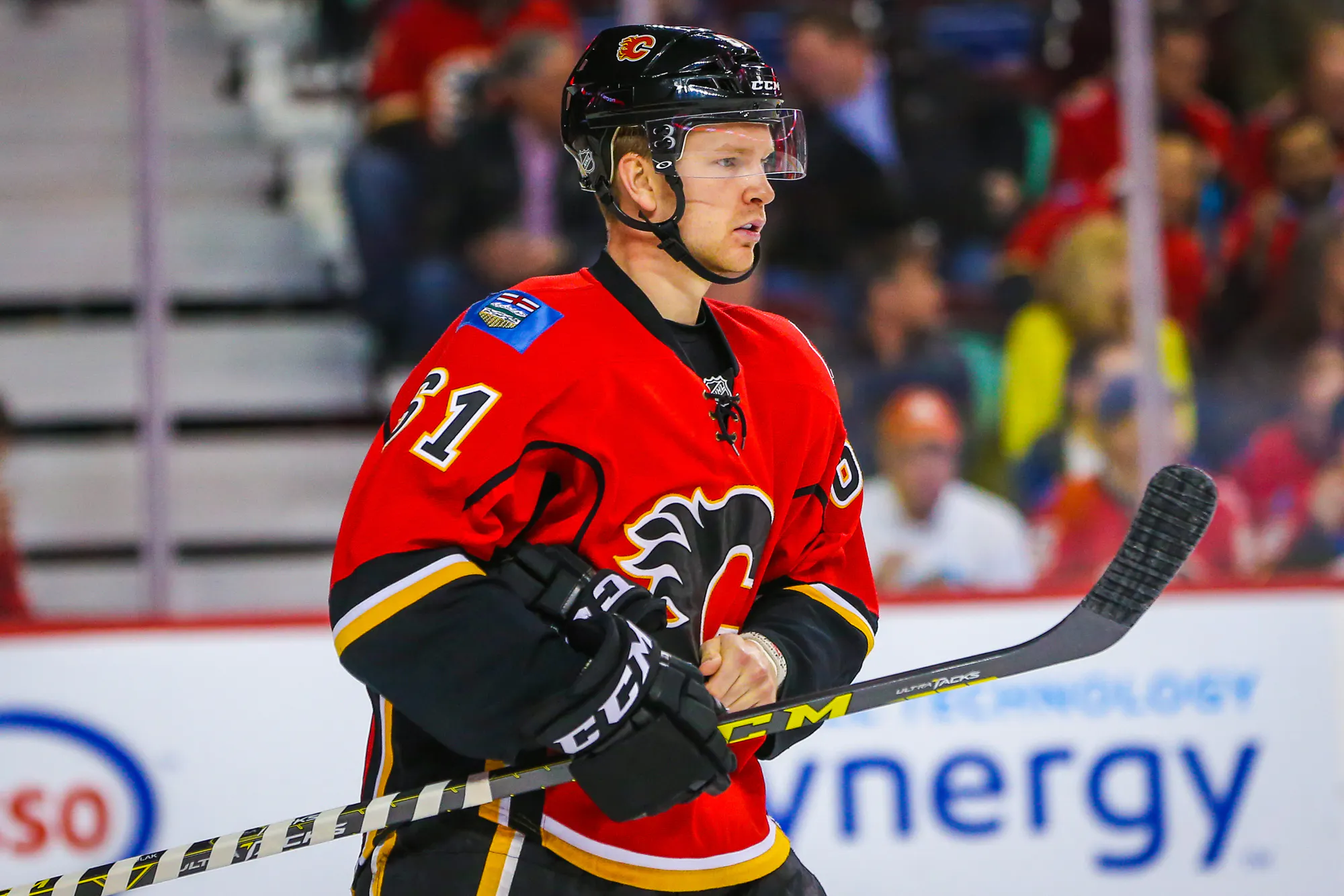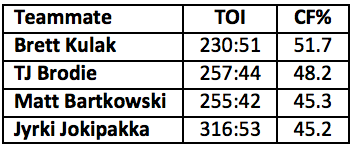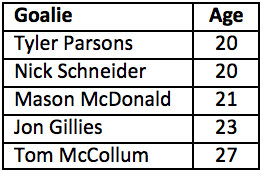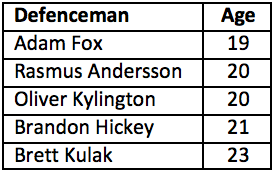To qualify or not to qualify?

By my rudimentary count (fingers and toes), the Calgary Flames have 12 pending restricted free agents this summer and will have to decide whether or not to extend a qualifying offer in each instance. By extending an offer before the June 26 deadline, a team will retain that player’s rights regardless if it’s accepted or not. Players who are not tendered offers, on the other hand, immediately become unrestricted free agents.
While a few of Calgary’s RFA decisions are fairly easy, they’ve got more than a handful of difficult choices to make over the next two months.
Much of this conversation is framed by how the Flames went about their business last summer. Calgary had 13 pending RFAs one year ago but decided to qualify just four, which was a departure from the team’s approach in prior offseasons. The Flames have back pressure and decent depth in their system right now, which makes it very possible we see the summer of 2017 play out in a similar fashion, at least in terms of qualified players.
It’s a pretty safe assumption Calgary will extend offers to Sam Bennett, Micheal Ferland, Curtis Lazar, and Alex Chiasson, and as such, they’re not included in the coming analyses. I’ve split the remaining eight into two categories, which essentially break down to a “yes” column and a “maybe/no” column.
To qualify
Jon Gillies. Gillies just completed his first full professional regular season with the AHL’s Stockton Heat and posted decent, but not spectacular totals. Splitting time with the slightly older David Rittich (more on him later), Gillies was the clear runner-up statistically.

While Gillies didn’t have the greatest first full season in the American League, it still makes sense to qualify him and keep him within the organization. Gillies is a former third round pick, is still just 23 years old, and his ceiling remains pretty high. Additionally, he looked solid in winning his NHL debut against the L.A. Kings near the end of the season.
On the flip side, Gillies is no longer the organization’s clear top goaltending prospect. That’s mainly because the last calendar year for 2016 second round pick Tyler Parsons has Flames fans and decision makers alike extremely excited; personally, he’s the prospect I’m most excited about right now, regardless of position.
That, coupled with Gillies’ average first AHL year likely takes him out of the “guarantee” category on the qualifying front. That said, with his combination of size (6’6, 223 pounds) and agility, his impressive NCAA track record, and his status as a former draft pick, I think it makes sense for Calgary to qualify him, and I’d be surprised if they didn’t.
Brett Kulak. If I were making the decisions, this wouldn’t even be a conversation: Kulak would be qualified and signed, because I think he’s a bona fide NHL defenceman right now. Everything I’ve seen from him at the highest level leads me to believe he’s ready for a full time gig with the Flames. However, I’m not sure the team is 100% on the same page.
Kulak played just 21 games in Calgary this season and saw plenty of time in the press box while looking up at players like Dennis Wideman, Jyrki Jokipakka, and Matt Bartkowski on the depth chart. It’s my contention he’s an upgrade on all three and should have been a far more regular part of the Flames’ blueline in 2016-17. That’s not how the organization saw things, though.
Kulak’s underlying numbers certainly support my contention. His 50.6% possession rate was third on the team among d-men, behind only Mark Giordano and Dougie Hamilton. Obviously Kulak didn’t see the type of competition those two, or T.J. Brodie, saw, but he wasn’t sheltered either. With a 45.7% offensive zone start ratio, Kulak’s possession numbers were noticeably superior to guys with more o-zone starts (Bartkowski, Jokipakka, Wideman), and significantly better than Deryk Engelland’s with similar usage.
Kulak’s impact can further be explained by looking at his most frequent partner’s results. Below are Engelland’s outputs with the four guys he played most with this season. Again, the results with Kulak in comparison are better across the board. For context, Engelland was playing much tougher competition when paired with Brodie, and that does impact the outputs.

The Flames should absolutely qualify Kulak and he should be part of their full-time blueline mix next season. That’s my opinion, of course, but even though I’m not certain it’s fully shared by hockey ops, I still think he’s pretty close to a slam-dunk for a qualifying offer.
Garnet Hathaway. Let’s get this out of the way: the Flames went 18-7-1 with Hathaway in the lineup. Let’s also get this out of the way: that has absolutely zero bearing on where I stand on his qualifying offer. As a fourth line forward averaging 9:08 of ice time per game, Hathaway had a negligible impact on wins and and losses, and certainly nowhere near enough of one to correlate that record to his presence. In saying that, I think it mostly makes sense for Calgary to qualify Hathaway.
Mainly, I think Hathaway is an affordable, short-term, bottom six option for the Flames and projects to fill a similar role as Lance Bouma going forward. The big difference here is price. While Bouma’s cap hit is $2.2 million for next season, Hathaway’s qualifying offer would come in at $715,000. A discrepancy of $1.5 million for comparable results doesn’t make a ton of sense and tilts the scales in a big way towards Hathaway.

Both Hathaway and Bouma are largely replaceable players, but going forward, Hathaway makes more sense to keep in the fold. He’s younger and cheaper, and most importantly, the organization seems to like him. I think the Flames will qualify Hathaway, and, knowing the price he’ll come in at, it’s tough to be staunchly for or against that decision.
Or not?
David Rittich. Here’s where things get interesting. As laid out above, Rittich’s season was superior to his AHL counterpart Gillies. In fact, the 2016 free agent signing had solid numbers period: Rittich’s 0.924 SV% was top 10 in the American League and was only two ticks off the circuit’s second best total. All things considered, keeping Rittich in the fold makes a ton of sense, and that very well could be the outcome here. However, his situation is slightly more complicated.
Rittich will turn 25 in August and, unlike Gillies, is not a Calgary drafted and developed product. That likely wouldn’t matter in most circumstances, but right now the Flames are jammed with bodies between the pipes. Rittich is one of six organizational goalies currently, not to mention whoever is on the big team next season (ages below are to start the 2016-17 season).

Both Parsons and Schneider are eligible to turn pro next season, and it’s almost a given the former will do just that. If that’s the case, Parsons needs to get quality minutes, so hampering his development with three goalies at the AHL level makes no sense. Schneider, McDonald, and McCollum aren’t really factors at the AHL level next year, but even so, a scenario with Parsons, Gillies, and Rittich in Stockton is one to avoid. Is ECHL Adirondack an option? Yeah, maybe, but not the most desirable one, at least in my opinion.
In a lot of ways, Rittich’s fate might be determined by what Calgary does at the NHL level. If they go with a tandem of somewhat experienced goalies again, Rittich could end up being an odd man out. However, if the Flames are cool giving a younger guy backup minutes behind an established number one, there might be ample room after all.
Regardless, even if my read is off here, I think Rittich’s qualifying decision could go either way. If it’s me, I’m all for bringing him back under ideal circumstances. It remains to be seen if those circumstances will exist.
Tyler Wotherspoon. Wotherspoon finds himself in a very similar situation as Rittich, just at a different position. Once viewed as contemporaries, I think Kulak has surpassed Wotherspoon on the depth chart and potentially put a few bodies between them. To muddy things even more, Calgary’s organization blueline depth has really taken a step forward in recent years (ages below are to start the 2016-17 season).

I’ve always been a fan of Wotherspoon’s, but in saying that, he’s got a battle on his hands to stay relevant. While Fox and Hickey aren’t professional threats this season, they will be in the coming years, with the latter turning pro for the 2018-19 campaign.
Optimistically, two of Kulak, Andersson, Kylington, and Wotherspoon could make the opening day roster in October, which raises the question: where does Wotherspoon fit? This is less an indictment on Wotherspoon’s future as an NHLer, but more a product of Calgary’s depth on the backend. I still think the 2011 second round pick has third pairing chops, but I’m not sure that’ll come to fruition with the Flames.
Personally, I’d like to see Calgary qualify Wotherspoon one more time and see if he can’t push for an NHL job in training camp. But knowing how pragmatic the Flames were with QOs last summer, I’m not sure if that’s the direction they end up going.
Ryan Culkin. We’ll spend a little less time on the final three players here, starting with Culkin. The 2012 fifth round pick has had a hell of a time staying healthy the last few seasons, and there’s no question that’s hurt his development. But much like Wotherspoon, and to an even greater extent, Culkin seems lost on the organizational depth chart.
To make things more ominous for him, Culkin has spent significant time the last couple seasons in the ECHL. That doesn’t bode well for a guy who turns 24 in December and has been property of the team for five years. My guess is the Flames decide not to qualify Culkin, and I’d understand why.
Kenney Morrison. Unlike Culkin, Morrison wasn’t even drafted by Calgary, which makes his situation even less ideal. A college free agent signing two years ago, at least Morrison spent all of this season with Stockton and didn’t spend any time in the ECHL. But still, do we really see him projecting to the NHL at any point down the road?
Sure, guys surprise us and there’s a chance Morrison might turn into more at some point, but the Flames can’t operate on big maybes. If Calgary wants to keep him in the organization, then by all means, sign Morrison to an AHL-only deal. But at this point, a qualifying offer doesn’t make a ton of sense.
Linden Vey. How many remembered Vey was still in the organization? I don’t say that in a derogatory sense, it’s just that after being recalled for a four-game stint in November, we never saw Vey sniff an NHL game the rest of the season. With Vey turning 26 in July, he looks to have fallen into the “replacement level” category.
Vey does have a couple things going for him, though. He put up solid numbers in Stockton (15 goals, 55 points in 61 games), and head coach Glen Gulutzan is a fan. Will that be enough to get him a qualifying offer? Maybe, but if it doesn’t, Calgary will be able to find another player like him fairly easily.
Recent articles from Pat Steinberg





